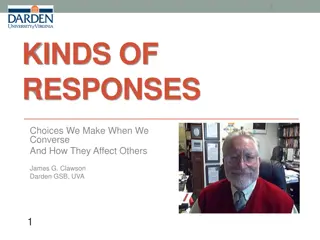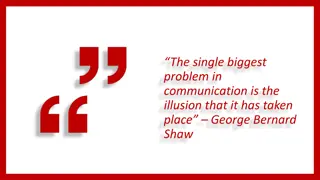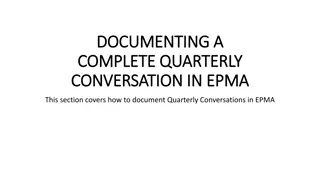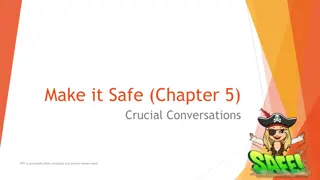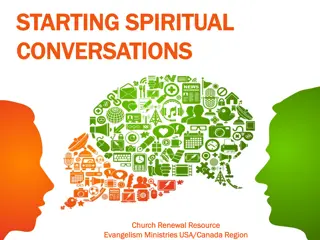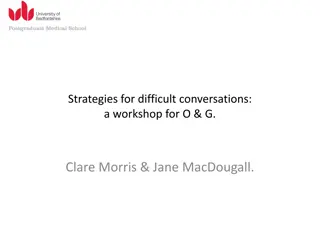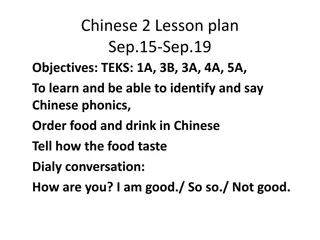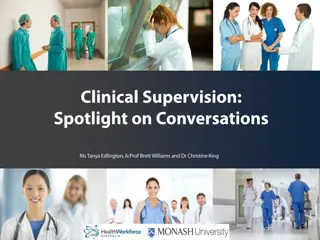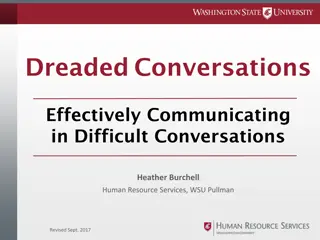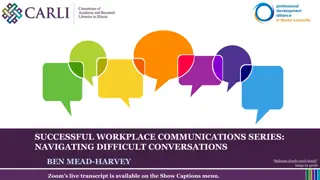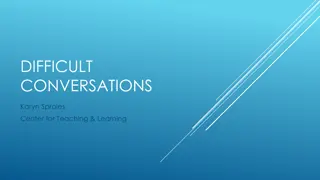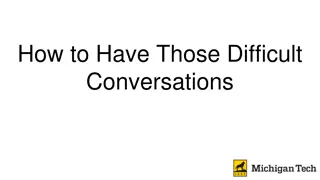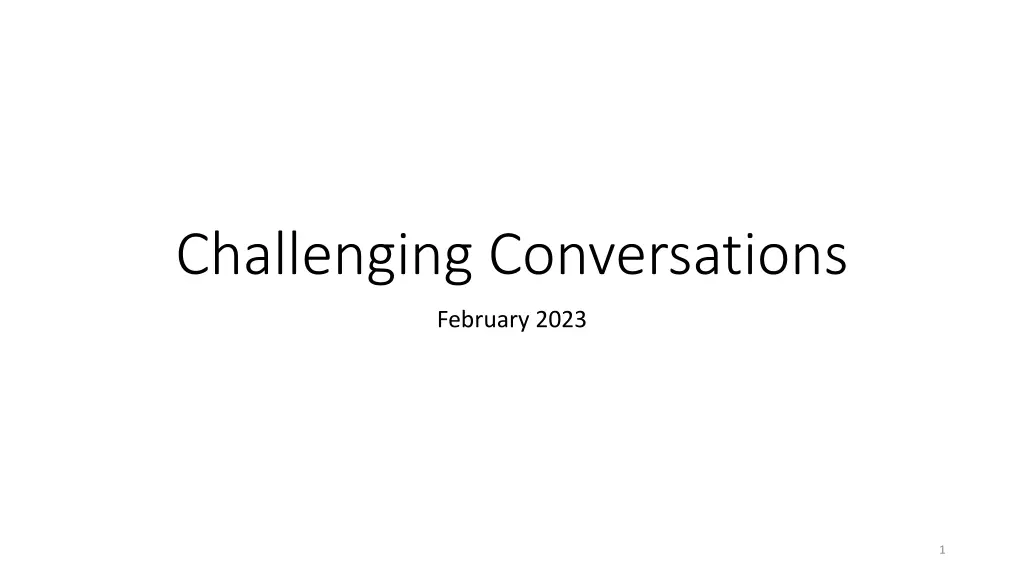
Understanding Challenging Conversations in Academic Settings
Explore the complexities of challenging conversations within academic environments, including difficult scenarios with faculty/staff and students. Learn why these conversations are challenging, the problem categories that may arise, and the performance formula to assess expectations, ability, and motivation for effective outcomes.
Download Presentation

Please find below an Image/Link to download the presentation.
The content on the website is provided AS IS for your information and personal use only. It may not be sold, licensed, or shared on other websites without obtaining consent from the author. If you encounter any issues during the download, it is possible that the publisher has removed the file from their server.
You are allowed to download the files provided on this website for personal or commercial use, subject to the condition that they are used lawfully. All files are the property of their respective owners.
The content on the website is provided AS IS for your information and personal use only. It may not be sold, licensed, or shared on other websites without obtaining consent from the author.
E N D
Presentation Transcript
Challenging Conversations February 2023 1
What kinds of conversations are challenging? Faculty/Staff: Not meeting expectations Student complaints (about faculty) Poor professional relationships Delivering unwelcome news Correcting poor performance or bad behavior When change is necessary Providing critical feedback 2
Why are these conversations challenging? Emotion Nobody likes criticism Fear Confrontation/conflict Material loss Loss of reputation or status Fear of litigation Culture Lack of accountability Little administrative support 3
Problem faculty/staff categories Complainers Procrastinators Prima donnas Confrontation junkies Early retirement mode Mental illness Narcissism People with unhappy lives Bullies Passive-aggressive Afraid of change Leave me alone to do my job/lone wolves Intolerant of others 4
Problem categories: Faculty Performance Teaching issues No/too little scholarship No/too little service Bad advising/lack of responsiveness Behavior Bullying Belligerence Passivity Attitude/whining Harassment Lack of responsiveness Self-righteousness/sense of superiority Only concerned with themselves Unrealistic expectations 5
Performance Formula (David Whetten) Performance = Expectations x Ability x Motivation/Consequences 1. Are your expectations clear? 2. Does the faculty member have the skills/ability to perform the job? Does the person have the necessary resources? 3. Is the person motivated to perform the job? Are the consequences (positive or negative) applied consistently and fairly? 6
Faculty Expectations Staff Expectations In the Faculty Handbook (minimum standards) Teaching, Scholarship/Research, Service In the employee s job description Vary by position If expectations are unclear, it is the supervisor s job to clarify them Performance = Expectations x Ability x Motivation/Consequences 7
Faculty Ability Staff Ability Hire for disciplinary knowledge/academic credentials Provost office & CELT provide resources for teaching skills & earning terminal degree ORSP provides resources for research/scholarship Hire for knowledge and skill HR provides resources/training if needed Is the person able to perform the job? Has he/she utilized the resources provided? Performance = Expectations x Ability x Motivation/Consequences 8
Internal Motivation External Motivation Serve students well Value Lutheran higher education Intellectual curiosity Paycheck Get advanced in rank/promoted Respected by others/status What motivates this person? How can you motivate them from the outside? Performance = Expectations x Ability x Motivation/Consequences 9
Anna had just been named department chair. Homer was a senior faculty member with a national reputation for scholarship in his field. In a department meeting, Homer used ridicule and sarcasm to belittle a colleague who proposed a modification to the curriculum. Nobody stood up to him. Everyone just kind of looked at the floor or at their notepads. Later, other faculty members told Anna that this was typical behavior on Homer s part. When Anna checked Homer s personnel file, she found nothing in writing about his behavior. 10
Problem categories: which of these describe(s) Homer? Performance Teaching issues No/too little scholarship No/too little service Bad advising/lack of responsiveness Behavior Bullying Belligerence Passivity Attitude/whining Harassment Lack of responsiveness Self-righteousness/sense of superiority Only concerned with themselves Unrealistic expectations 11
Homer: What went wrong? Nobody had ever called Homer on his behavior There is nothing in writing to document his behavior 12
Questions about/for Homer Does Homer realize that his behavior is not OK? Is he able to treat colleagues with respect, but choosing not to do so? Is this a behavior he can control? If so, why is he choosing not to behave respectfully? If not, what s going on (medical issue?) 13
Belinda was hired into the department and did OK at first. However, the department chair (Tony) began to hear from students that Belinda s lectures were disorganized, that she seldom covered all the material on the syllabus so they were always behind schedule, and her exam questions did not connect to what she covered in class. Many students stated this on the end of semester instructor evaluations. Tony considered bringing it up during the annual faculty evaluation meeting, but decided to let it go. He gave Belinda a positive review. 14
One day, several students came to Tonys office to tell him that Belinda was often late to class and was not returning their graded assignments for many weeks after they were turned in. They also stated that Belinda had ranted during class about university policies and national political figures with which she disagreed. Tony spoke to Belinda who insisted that she was not being treated fairly and that students were overly sensitive and had too much power over the faculty. Tony again gave Belinda a positive annual evaluation. 15
When Belinda applied to advance in rank, the committee turned down her request, citing low student ratings as their reason. Belinda sued the university, claiming breach of contract because her department chair (Tony) had consistently provided her with positive performance evaluations, leading her to believe she was on track for a promotion. 16
Belinda: What went wrong? Because Belinda s file does not contain any documentation of earlier conversations or actions concerning the issues raised, it appears that she was never warned about her performance Tony wanted to avoid tough conversations and to be friendly and supportive of his faculty member Tony did not follow the university s policy that annual faculty evaluations were to be accurate and truthful about actual faculty performance, and he failed to document Belinda s behavior. This will likely cost the university $$$ 17
Questions for Belinda Why are her courses so disorganized, and why is she having difficulty returning student work in a timely manner? Are there any resources available to assist her in addressing these issues? Has she used those? Is she aware of them? Why does she believe it is OK to use her classroom to rant (or complain ) about university policy and various politicians? 18
Whats needed? Clearly written policy and code of conduct or behavior Accurate feedback to faculty; while we want to be supportive, we must also be honest Written documentation of incidents, meetings, conversations 19
Radical Candor Care personally Ruinous empathy Radical candor Challenge Directly Obnoxious aggression Manipulative Insincerity 20
Radical Candor Example Care personally Ruinous empathy Radical candor Challenge Directly Obnoxious aggression Manipulative Insincerity 21
Radical Candor Care personally Stay silent so you do not hurt her feelings/embarrass her Quietly whisper or signal to her Ruinous empathy Radical Candor Challenge Directly Obnoxious aggression Manipulative Insincerity Yell Hey, you have spinach in your teeth so everyone can hear Stay silent so you do not feel awkward 22
Problem categories Performance Teaching issues No/too little scholarship No/too little service Bad advising/lack of responsiveness Behavior Bullying Belligerence Passivity Attitude/whining Harassment Lack of responsiveness Self-righteousness/sense of superiority Only concerned with themselves Unrealistic expectations CUWAA Faculty Handbook lists expectations; you can clarify those for your department if needed. 23
Performance Expectations Create department/program/school expectations for performance How much time to return graded student work? How much time to return student/faculty communications (emails, phone calls?) What is expected score on student course experience surveys? 24
Create a departmental behavior code (Code of conduct/collegiality) Created by, and voted on by, all department faculty members (give everyone multiple opportunities to revise, edit, contribute) A reflection of the values and beliefs of the department; a promise the group makes to one another Specific and concrete 25
Code of Collegiality example (anonymous university) Superior: actively promotes courtesy and harmony, politely takes a stand against incivility when it occurs, works for the good of the whole rather than personal gain or credit, is supportive of others, listens attentively, open and receptive to new ideas Successful: treats others with respect and courtesy, keeps private or sensitive information confidential, listens to others, disagrees without being disagreeable Unacceptable: ignores or violates behavioral norms or policies, arrogant and condescending, treats others as inferiors, interrupts others, threatens, degrades, insults or ignores others 26
Department Expectations: BYU example Attend meetings Arrive on time Come prepared Follow though with all assignments Be open to new ideas Assume positive intent Avoid side conversations Avoid sarcasm Seek to understand differences though dialog and discussion 27
Behavior issues: Code of Conduct Together, identify your values and clarify behavioral norms and expectations for everyone Revise, celebrate and uphold what you identify Use the norms/code/value statements as a standard against which you evaluate behavior and performance 28
Policy Know where to locate relevant policies; create them for your department if needed Where policies exist, follow them scrupulously Document all conversations, meetings, and decisions Make exceptions very judiciously; be aware of the possibility of favoritism, discrimination and setting precedent 29
What if: There is no policy that addresses the situation? You are asked to make an exception to the existing policy? 30
The 6 Steps (R. Kent Crookston) 1. Clarify values and expectations 2. Follow policy and document everything 3. Build trust with colleagues 4. Evaluate yourself and your perceptions 5. Listen 6. Take effective action LAW 32
The 6 Steps (R. Kent Crookson) 1. Clarify values and expectations 2. Follow policy and document everything 3. Build trust with colleagues 4. Evaluate yourself and your perceptions 5. Listen 6. Take effective action GOSPEL 33
Build trust, evaluate yourself & listen Hear everyone out; get the whole story Seek both factual and emotional truths Be open and transparent Evaluate your own biases and triggers Stay calm and ask questions Listen listen listen (but ban whining) 34
The 6 Steps (R. Kent Crookson) 1. Clarify values and expectations 2. Follow policy and document everything 3. Build trust with colleagues 4. Evaluate yourself and your perceptions 5. Listen 6. Take effective action ( The challenging conversation ) 35
Poor performance or troubling behavior cannot be ignored Be fair to others who are performing well and playing by the rules Follow your policy and/or code Faculty handbook, employee handbook, department code of values or behaviors and expectations Be transparent and candid with the faculty member Describe the gap between expectations and observed behavior/performance Explain the negative impact on students, other faculty, university mission, etc. Be clear about what must change, when it must change, what will happen if it does not change (performance improvement plan) 36
Taking effective action (the difficult conversation) After the department created and adopted a Department Code of Civility , Homer interrupted a junior colleague to criticize her proposal. His tirade included words like stupid , incompetent , crappy and disgusted . What should Anna do? 37
Act quickly Homer, that comment violates the civility agreement we have in this department. Would you please express your opinion in a manner that fits within our agreement? (If he does so, the meeting can continue but at the end, Anna must tell him to come to her office as soon as possible) If he does not do so, Anna should adjourn the meeting immediately and tell Homer to come to her office. She should invite her dean or someone from HR office to be present. DO NOT DO THESE MEETINGS ALONE. 38
The conversation Describe the gap between what happened and what was supposed to happen Homer, what you just said to Ellen was inappropriate. It was a personal attack and it violated our agreed-upon Code of Civility. Tell me about the gap between our expectations of one another and what you did. 39
When Homer defends himself or makes excuses: Explain the negative impact that the behavior has on others (students, colleagues, department s reputation, etc.) Remind Homer that complying with the department s code is not a suggestion; it s a requirement of his position Homer, we greatly value your experience and skills, but we also have to consider the cost of your conduct and the negative impact it has on our department climate and on your colleagues, especially Ellen. Civil behavior is a requirement, not a suggestion. 40
When Homer continues to argue: Remind him that there are consequences for how we choose to behave I am going to document this incident in your personnel file, and I will be writing a Performance Improvement Plan to ensure that you understand the consequences of your actions and your choices. I hope that this will not happen again. Follow up with Performance Improvement Plan stating consequences if behavior re-occurs 41
An example of meeting notes After receiving 3 complaints from students, I met with MK (faculty member) at a time that she said was convenient (insert date and time here). I presented the students emails to MK and asked her to comment. She replied that those 3 students were always complaining and asked why I was focusing on them rather than on the other students who had not complained. I asked her to suggest how she might address the specifics of these complaints. She stated that she would not pander to the lowest common denominator . 42
MK continued I suggested she think back to when she was a student and asked how she would have wanted her complaints handled. She sighed loudly. I then asked her to provide me with a specific written plan within 3 days that described how she intended to address the complaints and rectify the situation. I sent a follow-up email thanking her for meeting with me and repeating my expectations, asking her to review them and to respond (within a short time frame) if she did not understand those expectations.. In the email, I stated that we would follow up within (time frame) to assess how she had addressed the complaints and reminded her that the university does not tolerate retaliation; any documented retaliation can lead to dismissal. 43
Zelda, your student ratings are consistently low. The comments state that students are not learning in your courses, and that you are often not present during scheduled office hours. We expect our faculty to be strong teachers who are available to help students. Tell me about the gap between this expectation and your performance. If Zelda makes excuses or deflects responsibility, she should be reminded that: Being an effective teacher who is responsive to students is a requirement, not a suggestion There are consequences for how we choose to behave We have to consider the negative impact of your classroom performance on our students and on our departmental climate and reputation Consequence: Performance improvement plan indicating specific expectations for progress toward improving teaching performance and accessibility; include resources provided to assist Zelda 44
Justin, yelling at a student is inappropriate. It was a personal attack and violated our department s code/university s expectations. Tell me about the gap between our expectations and what you did. If Justin tries to justify his behavior, he should be reminded that: Complying with the department s code of behavior is a requirement, not a suggestion There are consequences for how we choose to behave We have to consider the negative impact of your behavior on our students and on our departmental climate and reputation Consequence: Performance improvement plan indicating what will happen if there is another documented incident of incivility 45
Emily, you have not done any peer-reviewed scholarly work for the past 4 years; the faculty handbook says that you should have a scholarly product every other year. Tell me about the gap between this expectation and your scholarship. If Emily makes excuses for her lack of scholarship, she should be reminded that: Scholarship is a requirement of the job, not a suggestion There are consequences for how we choose to behave Emily might need some help in this area: No overloads Mentoring for scholarship Encouragement to attend a conference in her discipline Consequence: Performance improvement plan indicating timeline for progress toward scholarly productivity; include resources provided to assist Emily & consequences of not meeting expectations 46
Performance Improvement Plan (PIP) Formal document outlining: Faculty member s low performance or inappropriate behavior Specific expectations for correcting performance or behavior Resources provided to assist the faculty member Notification of potential consequences for not meeting the stated expectations Notification that retaliation may result in dismissal DO NOT DO A PIP ALONE. Contact Provost office and HR for assistance and a template. Make sure your dean is aware of the issues. (In most cases, a conversation outlining the concerns is warranted before you do a PIP.) 47
Taking effective action Act quickly; don t ignore poor performance or uncivil behavior Keep notes, document everything, have a witness Look at patterns Always reward good behavior, never reward bad Sutton, RI (2007). The no a--hole rule: Building a civilized workplace and surviving one that isn t. New York: Warner Business Books. 48
Last thoughts It s important that the faculty member knows you care about them enough to be honest about your concerns Stick to descriptions of behavior (what happened or did not happen) and the impact of that behavior (who is harmed) Be consistent; treat all faculty fairly including those who are productive and collegial Be firm, clear and kind You are doing the right thing 49
References Crookston, R. Kent (2021). Working with Problem Faculty: A 6-Step Guide for Department Chairs. San Francisco, CA: Josey-Bass. www.departmentchairs.org Scott, Kim (2017). Radical Candor. New York: St. Martin s Press. Sutton, RI (2007). The no a--hole rule: Building a civilized workplace and surviving one that isn t. New York: Warner Business Books. 50

